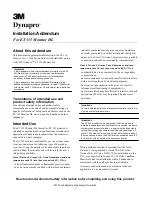
Page Number - 8
Form 801661B
8 . Reinstall the cap onto the fluid transfer bottle
and tighten it securely .
9 . Consult the vehicle manufacturer’s guidelines
for the proper wheel bleeding sequence and
pressure bleeding procedure .
10 . Observing the pressure gauge, operate the
hand pressure pump to achieve the recom-
mended pressure . Do not exceed 20 psi (1 .4
bar) pressure .
11 . Connect a bleed reservoir to the bleed screw of
the first cylinder to be bled .
12 . Open the bleed screw . Allow fluid to flow out
until only clear new fluid with no visible air
bubbles is streaming from the screw, and then
re-tighten the bleed screw to the manufac-
turer’s recommended torque .
13 . Perform the same procedure on all remaining
bleed screws . Operate the pressure pump as
required to maintain adequate pressure .
NOTE: Do not allow the fluid transfer bottle
and master cylinder reservoir to run dry . Use
the pressure relief lever on the hand pump to
relieve the system pressure and add new fluid if
necessary .
14 . Once bleeding is complete, relieve the pressure
in the system by activating the pressure relief
lever on the hand pump .
15 . Close the fluid dispensing hose shutoff valve,
disconnect the fluid hose by pulling back on
the coupler sleeve, and carefully remove the
adapter from the master cylinder, being careful
not spill any brake fluid .
16 . Extract excess fluid or top-off the master cylin-
der as required, and replace the cap .
17 . Dispose of any hydraulic fluid remaining in the
fluid transfer bottle . Do not store hydraulic
fluid in the bottle . Clean the fluid transfer
bottle assembly with denatured alcohol and
store it properly .
18 . Test the brake or clutch system for leaks before
driving the car .
Vacuum Brake Bleeding
The Fluid Transfer Accessory Kit provides a simple,
clean, and quick method for vacuum bleeding
the fluid lines in an automotive brake system . It
operates by creating a vacuum in the bottle, which
draws fluid from the lines via the wheel cylinder
bleed screws .
1 . Ensure the vehicle is properly positioned for
safe, convenient access to the master cylinder,
and the brake bleed screw located on each
wheel brake cylinder . Set the parking brake,
turn off the engine, and open and secure the
hood .
NOTE: Make certain the master cylinder reser-
voir is filled and a supply of new, clean brake
fluid of the proper type is on hand to top off
the reservoir as the fluid level drops during
bleeding . Make sure all the bleeding fittings
are clean prior to beginning of the bleeding
procedure .
NOTE: Consult the vehicle manufacturer’s
guidelines for the proper wheel bleeding
sequence and vacuum bleeding procedure .
2 . Disconnect the quick-change coupler from the
end of the fluid hose extending from the bot-
tom of the fluid transfer bottle by pulling back
on the blue sleeve of the coupler to release it
from the hose .
3 . Insert the appropriate brake bleed adapter into
the end of the fluid hose in place of the coupler .
NOTE: Brake bleed adapters are not included
with the fluid transfer accessory kit, but come
standard with most Mityvac hand pump kits,
or can be purchased separately . In many cases,
the end of the fluid hose can be slipped directly
onto the bleed screw nipple, eliminating the
need for a brake bleed adapter .
4 . Following the vehicle manufacturer’s recom-
mended bleed procedure, hang the fluid
transfer bottle assembly in a safe, secure loca-
tion within reach of the first wheel cylinder to
be bled, and open the shut-off valve located on
the fluid hose assembly .
5 . Connect a Mityvac hand vacuum pump to the
inlet hose extending from the side of the fluid
transfer bottle .
6 . Slide a wrench securely onto the hex of the
wheel cylinder bleed screw, and then slip the
bleed screw adapter or fluid hose over the
bleed screw nipple .
7 . Operate the hand pump 10 to 15 times to build
vacuum in the fluid transfer bottle, and turn
the wrench to open the fitting only enough to
allow fluid to flow; usually 1/4 to 1/2 turn .
NOTE: A tiny stream of bubbles may be
noticed in the hose after all of the air is bled
from the lines . This is caused by air seeping
around the threads of the loosened bleeder
fitting and being drawn back through the fit-
ting by the suction of the pump . Once the air
is removed from within the system, these tiny
bubbles will in no way jeopardize the bleeding
operation, since they are present only at the
fitting and do not enter the system . Applying
grease or Teflon tape around the threads of the
fitting will eliminate most of the bubbles .









































